PPMP20009: Home Construction Project Management Report
VerifiedAdded on 2022/08/24
|12
|3901
|18
Report
AI Summary
This report details a project management plan for constructing a client's home within a specified budget and timeline, incorporating PRINCE2 and Lean Project Management methodologies. The report addresses key aspects such as finalizing client requirements through architectural design and resource planning, establishing effective communication with stakeholders including contractors, subcontractors, and vendors, and efficiently managing these subcontractors and vendors through clear agreements and performance monitoring. The report emphasizes the importance of lean management practices to maximize resource utilization and minimize waste, particularly in relation to client specifications and communication. It also discusses practical application of Lean Project Management principles to ensure optimal outcomes and client satisfaction. The report emphasizes the importance of lean management practices to maximize resource utilization and minimize waste, particularly in relation to client specifications and communication.
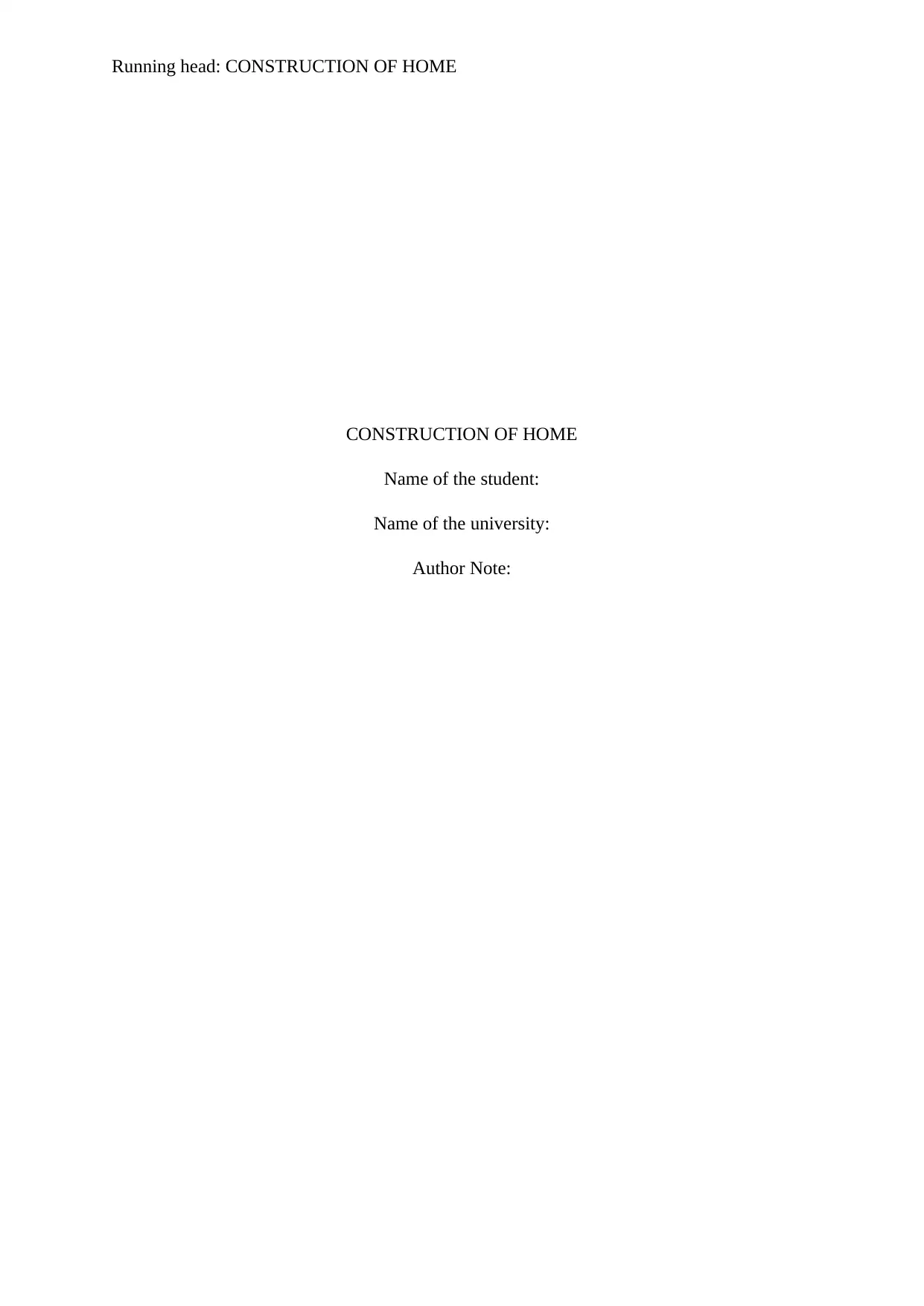
Running head: CONSTRUCTION OF HOME
CONSTRUCTION OF HOME
Name of the student:
Name of the university:
Author Note:
CONSTRUCTION OF HOME
Name of the student:
Name of the university:
Author Note:
Secure Best Marks with AI Grader
Need help grading? Try our AI Grader for instant feedback on your assignments.
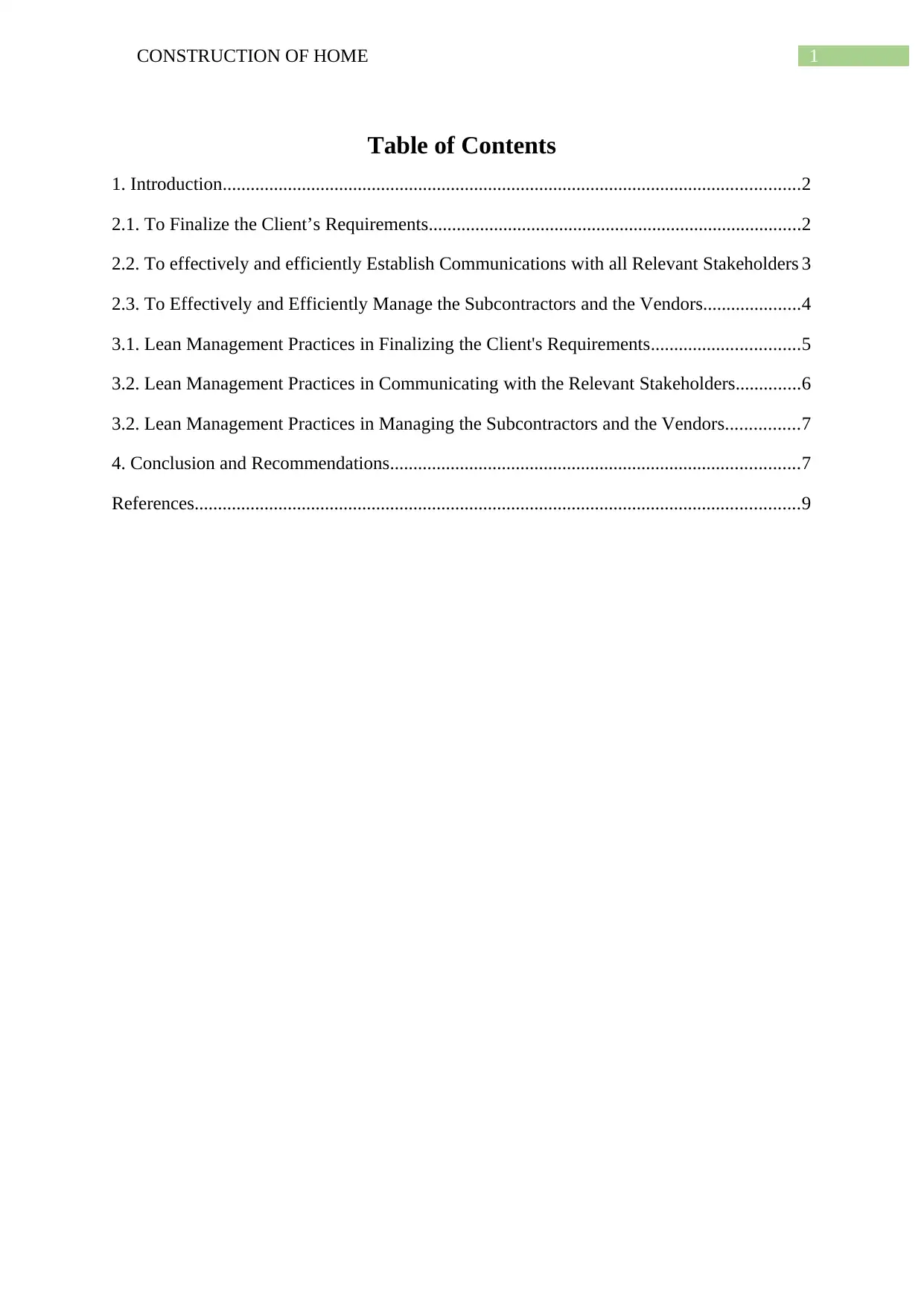
1CONSTRUCTION OF HOME
Table of Contents
1. Introduction............................................................................................................................2
2.1. To Finalize the Client’s Requirements................................................................................2
2.2. To effectively and efficiently Establish Communications with all Relevant Stakeholders 3
2.3. To Effectively and Efficiently Manage the Subcontractors and the Vendors.....................4
3.1. Lean Management Practices in Finalizing the Client's Requirements................................5
3.2. Lean Management Practices in Communicating with the Relevant Stakeholders..............6
3.2. Lean Management Practices in Managing the Subcontractors and the Vendors................7
4. Conclusion and Recommendations........................................................................................7
References..................................................................................................................................9
Table of Contents
1. Introduction............................................................................................................................2
2.1. To Finalize the Client’s Requirements................................................................................2
2.2. To effectively and efficiently Establish Communications with all Relevant Stakeholders 3
2.3. To Effectively and Efficiently Manage the Subcontractors and the Vendors.....................4
3.1. Lean Management Practices in Finalizing the Client's Requirements................................5
3.2. Lean Management Practices in Communicating with the Relevant Stakeholders..............6
3.2. Lean Management Practices in Managing the Subcontractors and the Vendors................7
4. Conclusion and Recommendations........................................................................................7
References..................................................................................................................................9
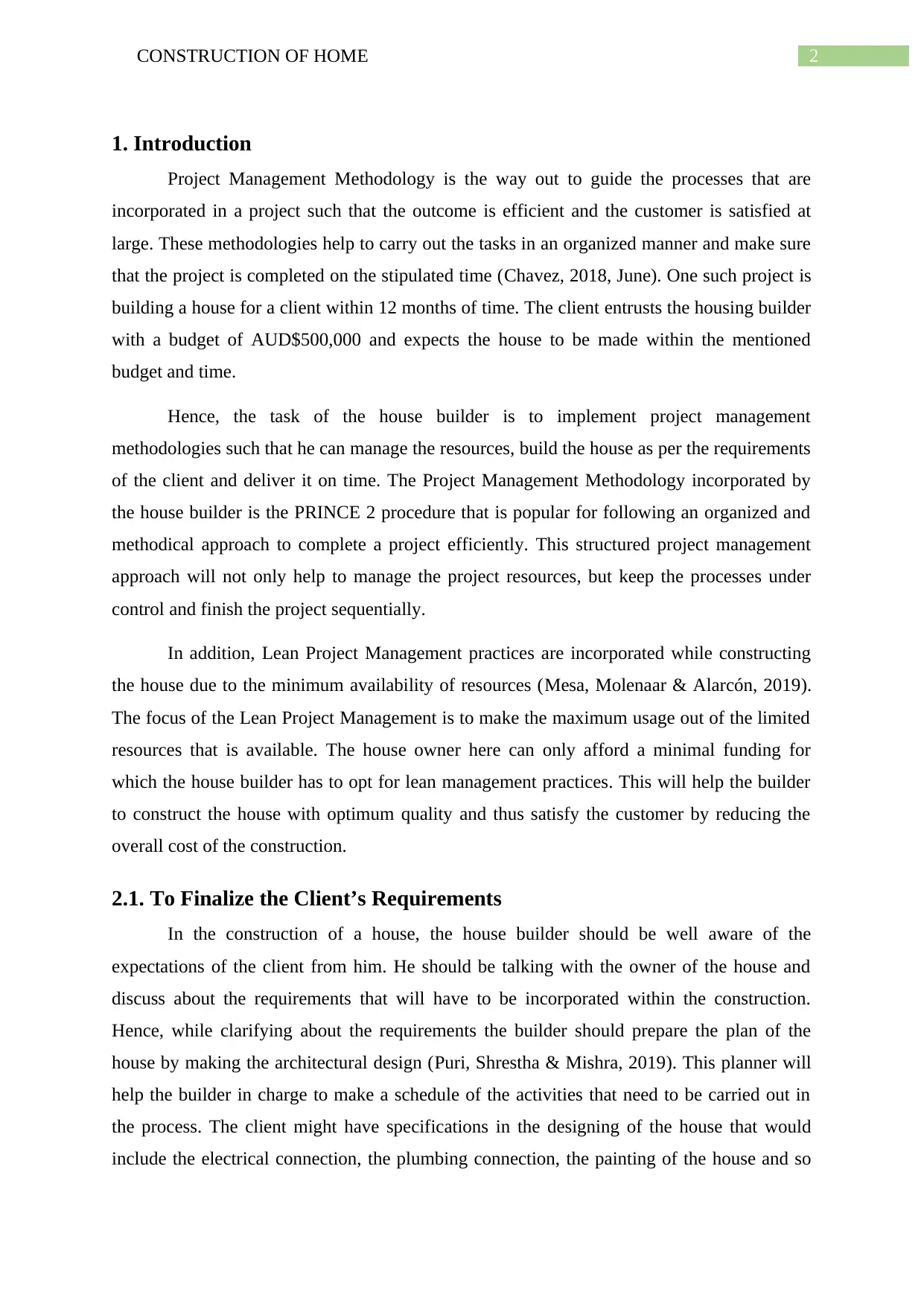
2CONSTRUCTION OF HOME
1. Introduction
Project Management Methodology is the way out to guide the processes that are
incorporated in a project such that the outcome is efficient and the customer is satisfied at
large. These methodologies help to carry out the tasks in an organized manner and make sure
that the project is completed on the stipulated time (Chavez, 2018, June). One such project is
building a house for a client within 12 months of time. The client entrusts the housing builder
with a budget of AUD$500,000 and expects the house to be made within the mentioned
budget and time.
Hence, the task of the house builder is to implement project management
methodologies such that he can manage the resources, build the house as per the requirements
of the client and deliver it on time. The Project Management Methodology incorporated by
the house builder is the PRINCE 2 procedure that is popular for following an organized and
methodical approach to complete a project efficiently. This structured project management
approach will not only help to manage the project resources, but keep the processes under
control and finish the project sequentially.
In addition, Lean Project Management practices are incorporated while constructing
the house due to the minimum availability of resources (Mesa, Molenaar & Alarcón, 2019).
The focus of the Lean Project Management is to make the maximum usage out of the limited
resources that is available. The house owner here can only afford a minimal funding for
which the house builder has to opt for lean management practices. This will help the builder
to construct the house with optimum quality and thus satisfy the customer by reducing the
overall cost of the construction.
2.1. To Finalize the Client’s Requirements
In the construction of a house, the house builder should be well aware of the
expectations of the client from him. He should be talking with the owner of the house and
discuss about the requirements that will have to be incorporated within the construction.
Hence, while clarifying about the requirements the builder should prepare the plan of the
house by making the architectural design (Puri, Shrestha & Mishra, 2019). This planner will
help the builder in charge to make a schedule of the activities that need to be carried out in
the process. The client might have specifications in the designing of the house that would
include the electrical connection, the plumbing connection, the painting of the house and so
1. Introduction
Project Management Methodology is the way out to guide the processes that are
incorporated in a project such that the outcome is efficient and the customer is satisfied at
large. These methodologies help to carry out the tasks in an organized manner and make sure
that the project is completed on the stipulated time (Chavez, 2018, June). One such project is
building a house for a client within 12 months of time. The client entrusts the housing builder
with a budget of AUD$500,000 and expects the house to be made within the mentioned
budget and time.
Hence, the task of the house builder is to implement project management
methodologies such that he can manage the resources, build the house as per the requirements
of the client and deliver it on time. The Project Management Methodology incorporated by
the house builder is the PRINCE 2 procedure that is popular for following an organized and
methodical approach to complete a project efficiently. This structured project management
approach will not only help to manage the project resources, but keep the processes under
control and finish the project sequentially.
In addition, Lean Project Management practices are incorporated while constructing
the house due to the minimum availability of resources (Mesa, Molenaar & Alarcón, 2019).
The focus of the Lean Project Management is to make the maximum usage out of the limited
resources that is available. The house owner here can only afford a minimal funding for
which the house builder has to opt for lean management practices. This will help the builder
to construct the house with optimum quality and thus satisfy the customer by reducing the
overall cost of the construction.
2.1. To Finalize the Client’s Requirements
In the construction of a house, the house builder should be well aware of the
expectations of the client from him. He should be talking with the owner of the house and
discuss about the requirements that will have to be incorporated within the construction.
Hence, while clarifying about the requirements the builder should prepare the plan of the
house by making the architectural design (Puri, Shrestha & Mishra, 2019). This planner will
help the builder in charge to make a schedule of the activities that need to be carried out in
the process. The client might have specifications in the designing of the house that would
include the electrical connection, the plumbing connection, the painting of the house and so
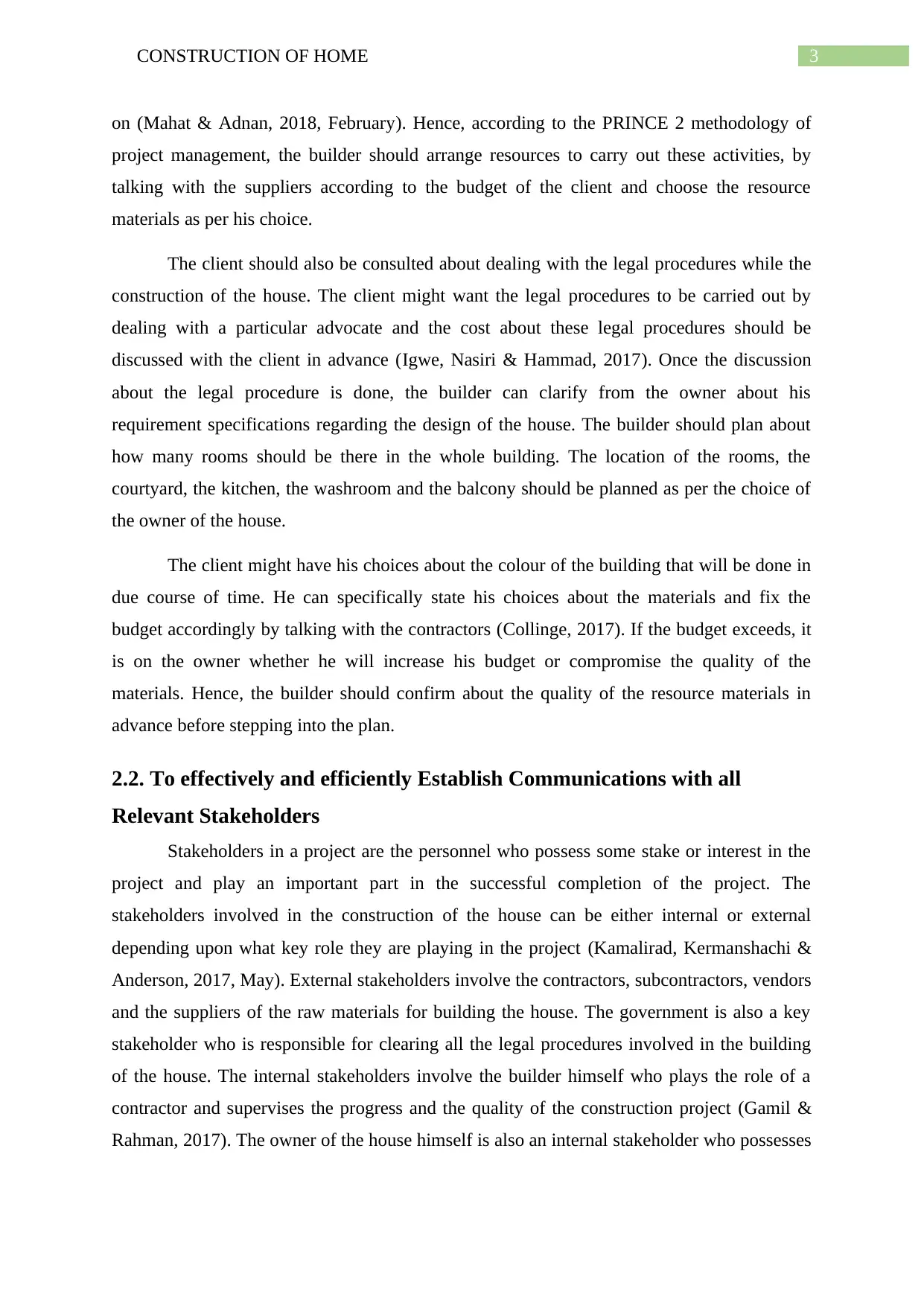
3CONSTRUCTION OF HOME
on (Mahat & Adnan, 2018, February). Hence, according to the PRINCE 2 methodology of
project management, the builder should arrange resources to carry out these activities, by
talking with the suppliers according to the budget of the client and choose the resource
materials as per his choice.
The client should also be consulted about dealing with the legal procedures while the
construction of the house. The client might want the legal procedures to be carried out by
dealing with a particular advocate and the cost about these legal procedures should be
discussed with the client in advance (Igwe, Nasiri & Hammad, 2017). Once the discussion
about the legal procedure is done, the builder can clarify from the owner about his
requirement specifications regarding the design of the house. The builder should plan about
how many rooms should be there in the whole building. The location of the rooms, the
courtyard, the kitchen, the washroom and the balcony should be planned as per the choice of
the owner of the house.
The client might have his choices about the colour of the building that will be done in
due course of time. He can specifically state his choices about the materials and fix the
budget accordingly by talking with the contractors (Collinge, 2017). If the budget exceeds, it
is on the owner whether he will increase his budget or compromise the quality of the
materials. Hence, the builder should confirm about the quality of the resource materials in
advance before stepping into the plan.
2.2. To effectively and efficiently Establish Communications with all
Relevant Stakeholders
Stakeholders in a project are the personnel who possess some stake or interest in the
project and play an important part in the successful completion of the project. The
stakeholders involved in the construction of the house can be either internal or external
depending upon what key role they are playing in the project (Kamalirad, Kermanshachi &
Anderson, 2017, May). External stakeholders involve the contractors, subcontractors, vendors
and the suppliers of the raw materials for building the house. The government is also a key
stakeholder who is responsible for clearing all the legal procedures involved in the building
of the house. The internal stakeholders involve the builder himself who plays the role of a
contractor and supervises the progress and the quality of the construction project (Gamil &
Rahman, 2017). The owner of the house himself is also an internal stakeholder who possesses
on (Mahat & Adnan, 2018, February). Hence, according to the PRINCE 2 methodology of
project management, the builder should arrange resources to carry out these activities, by
talking with the suppliers according to the budget of the client and choose the resource
materials as per his choice.
The client should also be consulted about dealing with the legal procedures while the
construction of the house. The client might want the legal procedures to be carried out by
dealing with a particular advocate and the cost about these legal procedures should be
discussed with the client in advance (Igwe, Nasiri & Hammad, 2017). Once the discussion
about the legal procedure is done, the builder can clarify from the owner about his
requirement specifications regarding the design of the house. The builder should plan about
how many rooms should be there in the whole building. The location of the rooms, the
courtyard, the kitchen, the washroom and the balcony should be planned as per the choice of
the owner of the house.
The client might have his choices about the colour of the building that will be done in
due course of time. He can specifically state his choices about the materials and fix the
budget accordingly by talking with the contractors (Collinge, 2017). If the budget exceeds, it
is on the owner whether he will increase his budget or compromise the quality of the
materials. Hence, the builder should confirm about the quality of the resource materials in
advance before stepping into the plan.
2.2. To effectively and efficiently Establish Communications with all
Relevant Stakeholders
Stakeholders in a project are the personnel who possess some stake or interest in the
project and play an important part in the successful completion of the project. The
stakeholders involved in the construction of the house can be either internal or external
depending upon what key role they are playing in the project (Kamalirad, Kermanshachi &
Anderson, 2017, May). External stakeholders involve the contractors, subcontractors, vendors
and the suppliers of the raw materials for building the house. The government is also a key
stakeholder who is responsible for clearing all the legal procedures involved in the building
of the house. The internal stakeholders involve the builder himself who plays the role of a
contractor and supervises the progress and the quality of the construction project (Gamil &
Rahman, 2017). The owner of the house himself is also an internal stakeholder who possesses
Secure Best Marks with AI Grader
Need help grading? Try our AI Grader for instant feedback on your assignments.
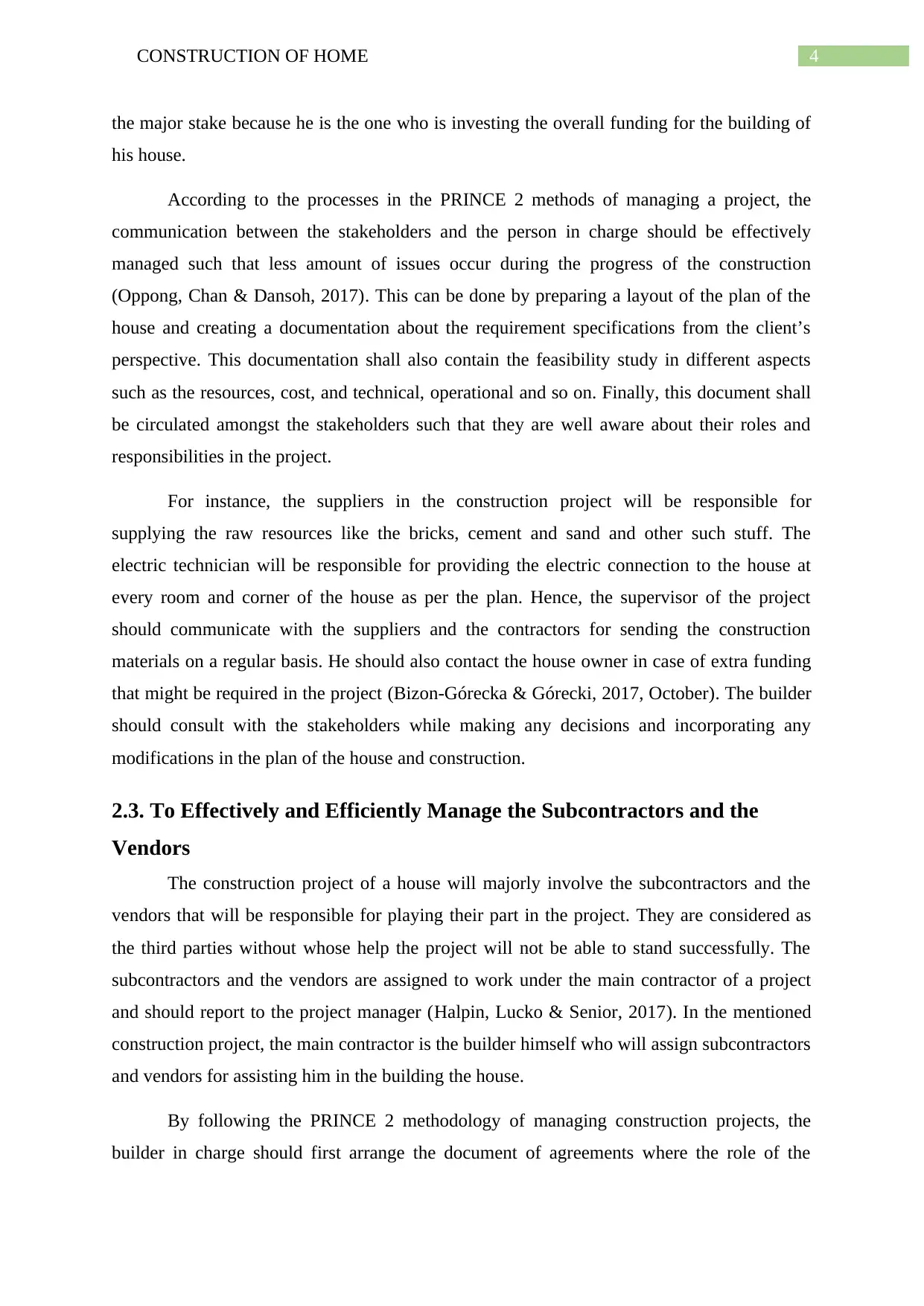
4CONSTRUCTION OF HOME
the major stake because he is the one who is investing the overall funding for the building of
his house.
According to the processes in the PRINCE 2 methods of managing a project, the
communication between the stakeholders and the person in charge should be effectively
managed such that less amount of issues occur during the progress of the construction
(Oppong, Chan & Dansoh, 2017). This can be done by preparing a layout of the plan of the
house and creating a documentation about the requirement specifications from the client’s
perspective. This documentation shall also contain the feasibility study in different aspects
such as the resources, cost, and technical, operational and so on. Finally, this document shall
be circulated amongst the stakeholders such that they are well aware about their roles and
responsibilities in the project.
For instance, the suppliers in the construction project will be responsible for
supplying the raw resources like the bricks, cement and sand and other such stuff. The
electric technician will be responsible for providing the electric connection to the house at
every room and corner of the house as per the plan. Hence, the supervisor of the project
should communicate with the suppliers and the contractors for sending the construction
materials on a regular basis. He should also contact the house owner in case of extra funding
that might be required in the project (Bizon-Górecka & Górecki, 2017, October). The builder
should consult with the stakeholders while making any decisions and incorporating any
modifications in the plan of the house and construction.
2.3. To Effectively and Efficiently Manage the Subcontractors and the
Vendors
The construction project of a house will majorly involve the subcontractors and the
vendors that will be responsible for playing their part in the project. They are considered as
the third parties without whose help the project will not be able to stand successfully. The
subcontractors and the vendors are assigned to work under the main contractor of a project
and should report to the project manager (Halpin, Lucko & Senior, 2017). In the mentioned
construction project, the main contractor is the builder himself who will assign subcontractors
and vendors for assisting him in the building the house.
By following the PRINCE 2 methodology of managing construction projects, the
builder in charge should first arrange the document of agreements where the role of the
the major stake because he is the one who is investing the overall funding for the building of
his house.
According to the processes in the PRINCE 2 methods of managing a project, the
communication between the stakeholders and the person in charge should be effectively
managed such that less amount of issues occur during the progress of the construction
(Oppong, Chan & Dansoh, 2017). This can be done by preparing a layout of the plan of the
house and creating a documentation about the requirement specifications from the client’s
perspective. This documentation shall also contain the feasibility study in different aspects
such as the resources, cost, and technical, operational and so on. Finally, this document shall
be circulated amongst the stakeholders such that they are well aware about their roles and
responsibilities in the project.
For instance, the suppliers in the construction project will be responsible for
supplying the raw resources like the bricks, cement and sand and other such stuff. The
electric technician will be responsible for providing the electric connection to the house at
every room and corner of the house as per the plan. Hence, the supervisor of the project
should communicate with the suppliers and the contractors for sending the construction
materials on a regular basis. He should also contact the house owner in case of extra funding
that might be required in the project (Bizon-Górecka & Górecki, 2017, October). The builder
should consult with the stakeholders while making any decisions and incorporating any
modifications in the plan of the house and construction.
2.3. To Effectively and Efficiently Manage the Subcontractors and the
Vendors
The construction project of a house will majorly involve the subcontractors and the
vendors that will be responsible for playing their part in the project. They are considered as
the third parties without whose help the project will not be able to stand successfully. The
subcontractors and the vendors are assigned to work under the main contractor of a project
and should report to the project manager (Halpin, Lucko & Senior, 2017). In the mentioned
construction project, the main contractor is the builder himself who will assign subcontractors
and vendors for assisting him in the building the house.
By following the PRINCE 2 methodology of managing construction projects, the
builder in charge should first arrange the document of agreements where the role of the
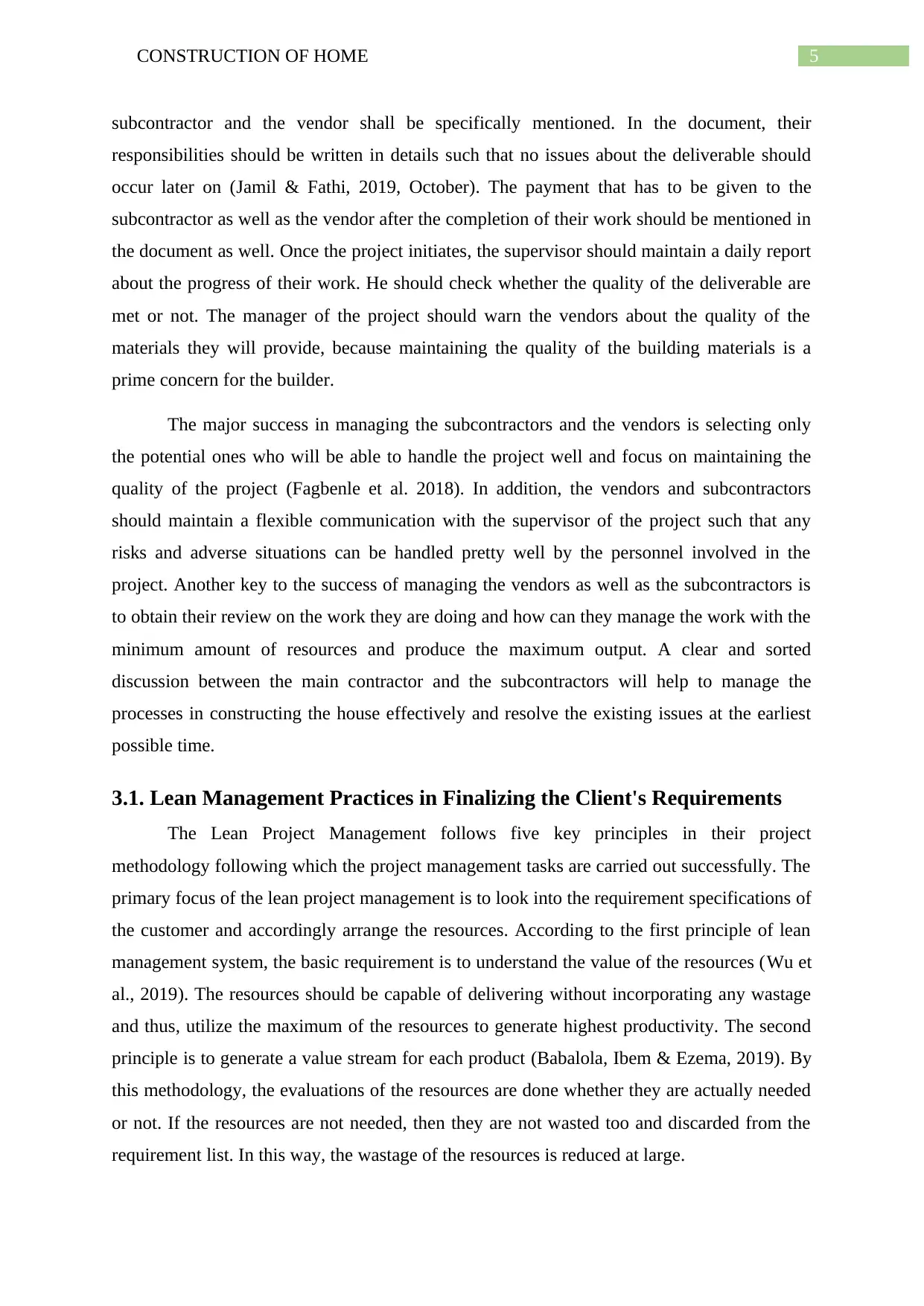
5CONSTRUCTION OF HOME
subcontractor and the vendor shall be specifically mentioned. In the document, their
responsibilities should be written in details such that no issues about the deliverable should
occur later on (Jamil & Fathi, 2019, October). The payment that has to be given to the
subcontractor as well as the vendor after the completion of their work should be mentioned in
the document as well. Once the project initiates, the supervisor should maintain a daily report
about the progress of their work. He should check whether the quality of the deliverable are
met or not. The manager of the project should warn the vendors about the quality of the
materials they will provide, because maintaining the quality of the building materials is a
prime concern for the builder.
The major success in managing the subcontractors and the vendors is selecting only
the potential ones who will be able to handle the project well and focus on maintaining the
quality of the project (Fagbenle et al. 2018). In addition, the vendors and subcontractors
should maintain a flexible communication with the supervisor of the project such that any
risks and adverse situations can be handled pretty well by the personnel involved in the
project. Another key to the success of managing the vendors as well as the subcontractors is
to obtain their review on the work they are doing and how can they manage the work with the
minimum amount of resources and produce the maximum output. A clear and sorted
discussion between the main contractor and the subcontractors will help to manage the
processes in constructing the house effectively and resolve the existing issues at the earliest
possible time.
3.1. Lean Management Practices in Finalizing the Client's Requirements
The Lean Project Management follows five key principles in their project
methodology following which the project management tasks are carried out successfully. The
primary focus of the lean project management is to look into the requirement specifications of
the customer and accordingly arrange the resources. According to the first principle of lean
management system, the basic requirement is to understand the value of the resources (Wu et
al., 2019). The resources should be capable of delivering without incorporating any wastage
and thus, utilize the maximum of the resources to generate highest productivity. The second
principle is to generate a value stream for each product (Babalola, Ibem & Ezema, 2019). By
this methodology, the evaluations of the resources are done whether they are actually needed
or not. If the resources are not needed, then they are not wasted too and discarded from the
requirement list. In this way, the wastage of the resources is reduced at large.
subcontractor and the vendor shall be specifically mentioned. In the document, their
responsibilities should be written in details such that no issues about the deliverable should
occur later on (Jamil & Fathi, 2019, October). The payment that has to be given to the
subcontractor as well as the vendor after the completion of their work should be mentioned in
the document as well. Once the project initiates, the supervisor should maintain a daily report
about the progress of their work. He should check whether the quality of the deliverable are
met or not. The manager of the project should warn the vendors about the quality of the
materials they will provide, because maintaining the quality of the building materials is a
prime concern for the builder.
The major success in managing the subcontractors and the vendors is selecting only
the potential ones who will be able to handle the project well and focus on maintaining the
quality of the project (Fagbenle et al. 2018). In addition, the vendors and subcontractors
should maintain a flexible communication with the supervisor of the project such that any
risks and adverse situations can be handled pretty well by the personnel involved in the
project. Another key to the success of managing the vendors as well as the subcontractors is
to obtain their review on the work they are doing and how can they manage the work with the
minimum amount of resources and produce the maximum output. A clear and sorted
discussion between the main contractor and the subcontractors will help to manage the
processes in constructing the house effectively and resolve the existing issues at the earliest
possible time.
3.1. Lean Management Practices in Finalizing the Client's Requirements
The Lean Project Management follows five key principles in their project
methodology following which the project management tasks are carried out successfully. The
primary focus of the lean project management is to look into the requirement specifications of
the customer and accordingly arrange the resources. According to the first principle of lean
management system, the basic requirement is to understand the value of the resources (Wu et
al., 2019). The resources should be capable of delivering without incorporating any wastage
and thus, utilize the maximum of the resources to generate highest productivity. The second
principle is to generate a value stream for each product (Babalola, Ibem & Ezema, 2019). By
this methodology, the evaluations of the resources are done whether they are actually needed
or not. If the resources are not needed, then they are not wasted too and discarded from the
requirement list. In this way, the wastage of the resources is reduced at large.
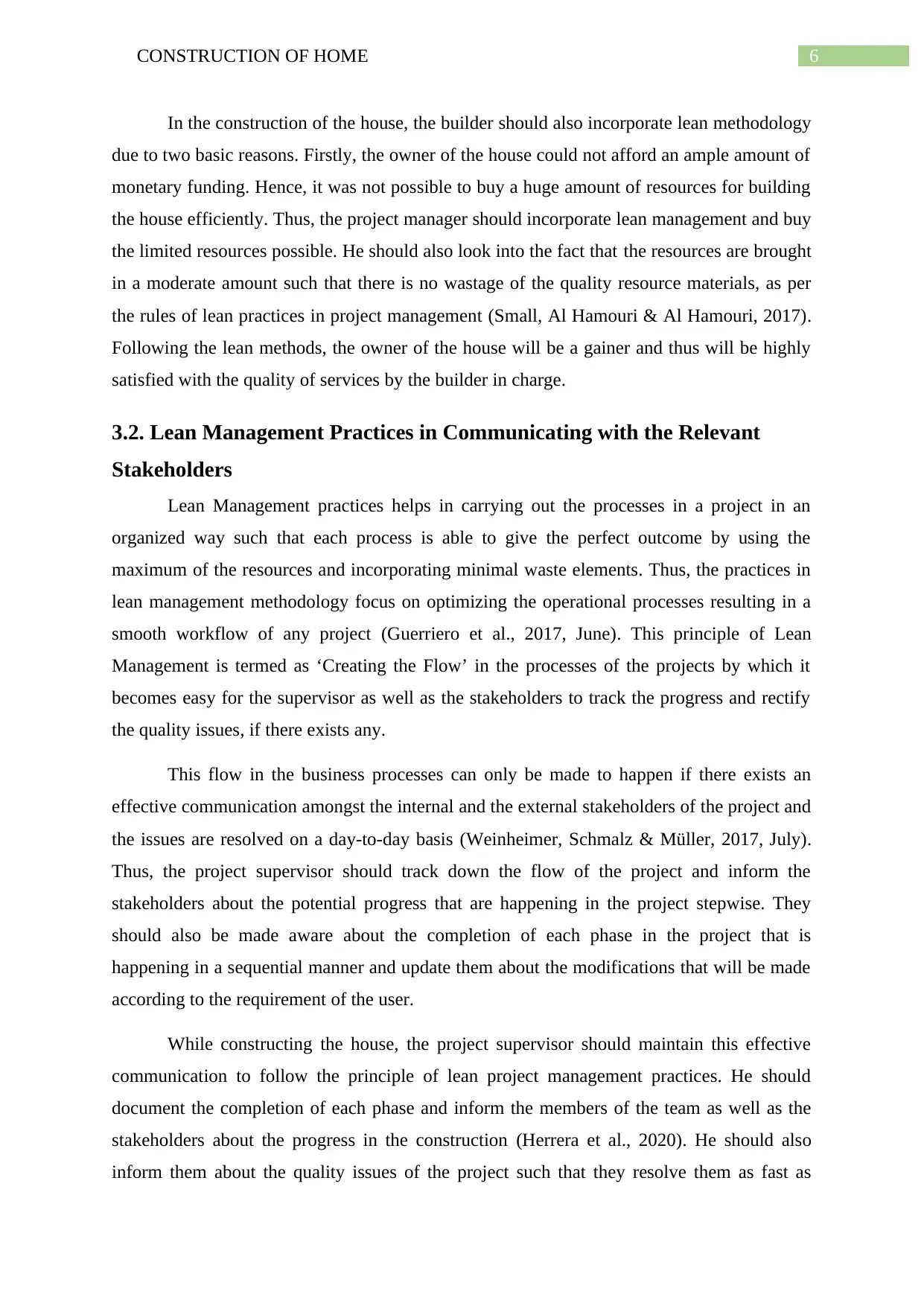
6CONSTRUCTION OF HOME
In the construction of the house, the builder should also incorporate lean methodology
due to two basic reasons. Firstly, the owner of the house could not afford an ample amount of
monetary funding. Hence, it was not possible to buy a huge amount of resources for building
the house efficiently. Thus, the project manager should incorporate lean management and buy
the limited resources possible. He should also look into the fact that the resources are brought
in a moderate amount such that there is no wastage of the quality resource materials, as per
the rules of lean practices in project management (Small, Al Hamouri & Al Hamouri, 2017).
Following the lean methods, the owner of the house will be a gainer and thus will be highly
satisfied with the quality of services by the builder in charge.
3.2. Lean Management Practices in Communicating with the Relevant
Stakeholders
Lean Management practices helps in carrying out the processes in a project in an
organized way such that each process is able to give the perfect outcome by using the
maximum of the resources and incorporating minimal waste elements. Thus, the practices in
lean management methodology focus on optimizing the operational processes resulting in a
smooth workflow of any project (Guerriero et al., 2017, June). This principle of Lean
Management is termed as ‘Creating the Flow’ in the processes of the projects by which it
becomes easy for the supervisor as well as the stakeholders to track the progress and rectify
the quality issues, if there exists any.
This flow in the business processes can only be made to happen if there exists an
effective communication amongst the internal and the external stakeholders of the project and
the issues are resolved on a day-to-day basis (Weinheimer, Schmalz & Müller, 2017, July).
Thus, the project supervisor should track down the flow of the project and inform the
stakeholders about the potential progress that are happening in the project stepwise. They
should also be made aware about the completion of each phase in the project that is
happening in a sequential manner and update them about the modifications that will be made
according to the requirement of the user.
While constructing the house, the project supervisor should maintain this effective
communication to follow the principle of lean project management practices. He should
document the completion of each phase and inform the members of the team as well as the
stakeholders about the progress in the construction (Herrera et al., 2020). He should also
inform them about the quality issues of the project such that they resolve them as fast as
In the construction of the house, the builder should also incorporate lean methodology
due to two basic reasons. Firstly, the owner of the house could not afford an ample amount of
monetary funding. Hence, it was not possible to buy a huge amount of resources for building
the house efficiently. Thus, the project manager should incorporate lean management and buy
the limited resources possible. He should also look into the fact that the resources are brought
in a moderate amount such that there is no wastage of the quality resource materials, as per
the rules of lean practices in project management (Small, Al Hamouri & Al Hamouri, 2017).
Following the lean methods, the owner of the house will be a gainer and thus will be highly
satisfied with the quality of services by the builder in charge.
3.2. Lean Management Practices in Communicating with the Relevant
Stakeholders
Lean Management practices helps in carrying out the processes in a project in an
organized way such that each process is able to give the perfect outcome by using the
maximum of the resources and incorporating minimal waste elements. Thus, the practices in
lean management methodology focus on optimizing the operational processes resulting in a
smooth workflow of any project (Guerriero et al., 2017, June). This principle of Lean
Management is termed as ‘Creating the Flow’ in the processes of the projects by which it
becomes easy for the supervisor as well as the stakeholders to track the progress and rectify
the quality issues, if there exists any.
This flow in the business processes can only be made to happen if there exists an
effective communication amongst the internal and the external stakeholders of the project and
the issues are resolved on a day-to-day basis (Weinheimer, Schmalz & Müller, 2017, July).
Thus, the project supervisor should track down the flow of the project and inform the
stakeholders about the potential progress that are happening in the project stepwise. They
should also be made aware about the completion of each phase in the project that is
happening in a sequential manner and update them about the modifications that will be made
according to the requirement of the user.
While constructing the house, the project supervisor should maintain this effective
communication to follow the principle of lean project management practices. He should
document the completion of each phase and inform the members of the team as well as the
stakeholders about the progress in the construction (Herrera et al., 2020). He should also
inform them about the quality issues of the project such that they resolve them as fast as
Paraphrase This Document
Need a fresh take? Get an instant paraphrase of this document with our AI Paraphraser
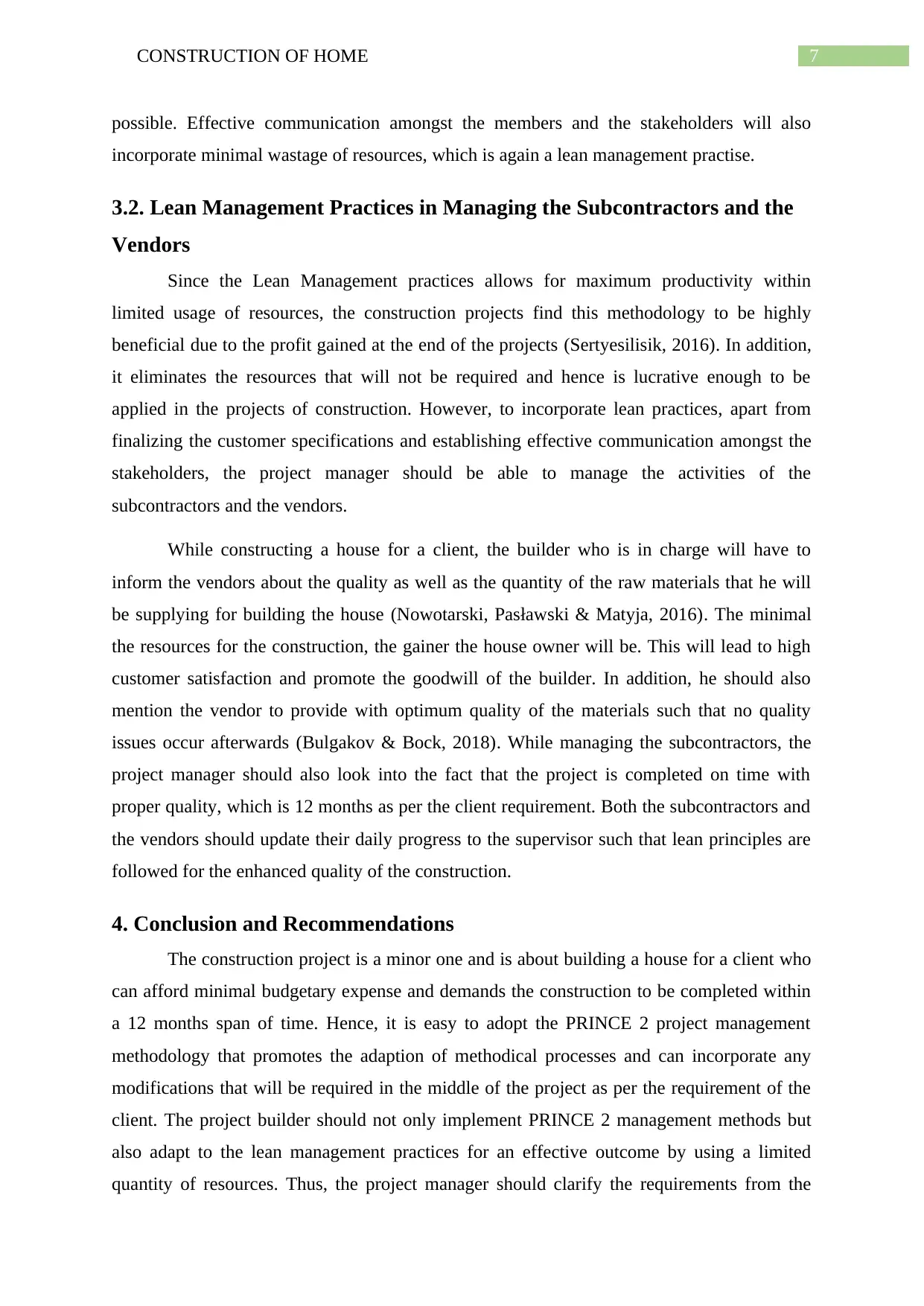
7CONSTRUCTION OF HOME
possible. Effective communication amongst the members and the stakeholders will also
incorporate minimal wastage of resources, which is again a lean management practise.
3.2. Lean Management Practices in Managing the Subcontractors and the
Vendors
Since the Lean Management practices allows for maximum productivity within
limited usage of resources, the construction projects find this methodology to be highly
beneficial due to the profit gained at the end of the projects (Sertyesilisik, 2016). In addition,
it eliminates the resources that will not be required and hence is lucrative enough to be
applied in the projects of construction. However, to incorporate lean practices, apart from
finalizing the customer specifications and establishing effective communication amongst the
stakeholders, the project manager should be able to manage the activities of the
subcontractors and the vendors.
While constructing a house for a client, the builder who is in charge will have to
inform the vendors about the quality as well as the quantity of the raw materials that he will
be supplying for building the house (Nowotarski, Pasławski & Matyja, 2016). The minimal
the resources for the construction, the gainer the house owner will be. This will lead to high
customer satisfaction and promote the goodwill of the builder. In addition, he should also
mention the vendor to provide with optimum quality of the materials such that no quality
issues occur afterwards (Bulgakov & Bock, 2018). While managing the subcontractors, the
project manager should also look into the fact that the project is completed on time with
proper quality, which is 12 months as per the client requirement. Both the subcontractors and
the vendors should update their daily progress to the supervisor such that lean principles are
followed for the enhanced quality of the construction.
4. Conclusion and Recommendations
The construction project is a minor one and is about building a house for a client who
can afford minimal budgetary expense and demands the construction to be completed within
a 12 months span of time. Hence, it is easy to adopt the PRINCE 2 project management
methodology that promotes the adaption of methodical processes and can incorporate any
modifications that will be required in the middle of the project as per the requirement of the
client. The project builder should not only implement PRINCE 2 management methods but
also adapt to the lean management practices for an effective outcome by using a limited
quantity of resources. Thus, the project manager should clarify the requirements from the
possible. Effective communication amongst the members and the stakeholders will also
incorporate minimal wastage of resources, which is again a lean management practise.
3.2. Lean Management Practices in Managing the Subcontractors and the
Vendors
Since the Lean Management practices allows for maximum productivity within
limited usage of resources, the construction projects find this methodology to be highly
beneficial due to the profit gained at the end of the projects (Sertyesilisik, 2016). In addition,
it eliminates the resources that will not be required and hence is lucrative enough to be
applied in the projects of construction. However, to incorporate lean practices, apart from
finalizing the customer specifications and establishing effective communication amongst the
stakeholders, the project manager should be able to manage the activities of the
subcontractors and the vendors.
While constructing a house for a client, the builder who is in charge will have to
inform the vendors about the quality as well as the quantity of the raw materials that he will
be supplying for building the house (Nowotarski, Pasławski & Matyja, 2016). The minimal
the resources for the construction, the gainer the house owner will be. This will lead to high
customer satisfaction and promote the goodwill of the builder. In addition, he should also
mention the vendor to provide with optimum quality of the materials such that no quality
issues occur afterwards (Bulgakov & Bock, 2018). While managing the subcontractors, the
project manager should also look into the fact that the project is completed on time with
proper quality, which is 12 months as per the client requirement. Both the subcontractors and
the vendors should update their daily progress to the supervisor such that lean principles are
followed for the enhanced quality of the construction.
4. Conclusion and Recommendations
The construction project is a minor one and is about building a house for a client who
can afford minimal budgetary expense and demands the construction to be completed within
a 12 months span of time. Hence, it is easy to adopt the PRINCE 2 project management
methodology that promotes the adaption of methodical processes and can incorporate any
modifications that will be required in the middle of the project as per the requirement of the
client. The project builder should not only implement PRINCE 2 management methods but
also adapt to the lean management practices for an effective outcome by using a limited
quantity of resources. Thus, the project manager should clarify the requirements from the
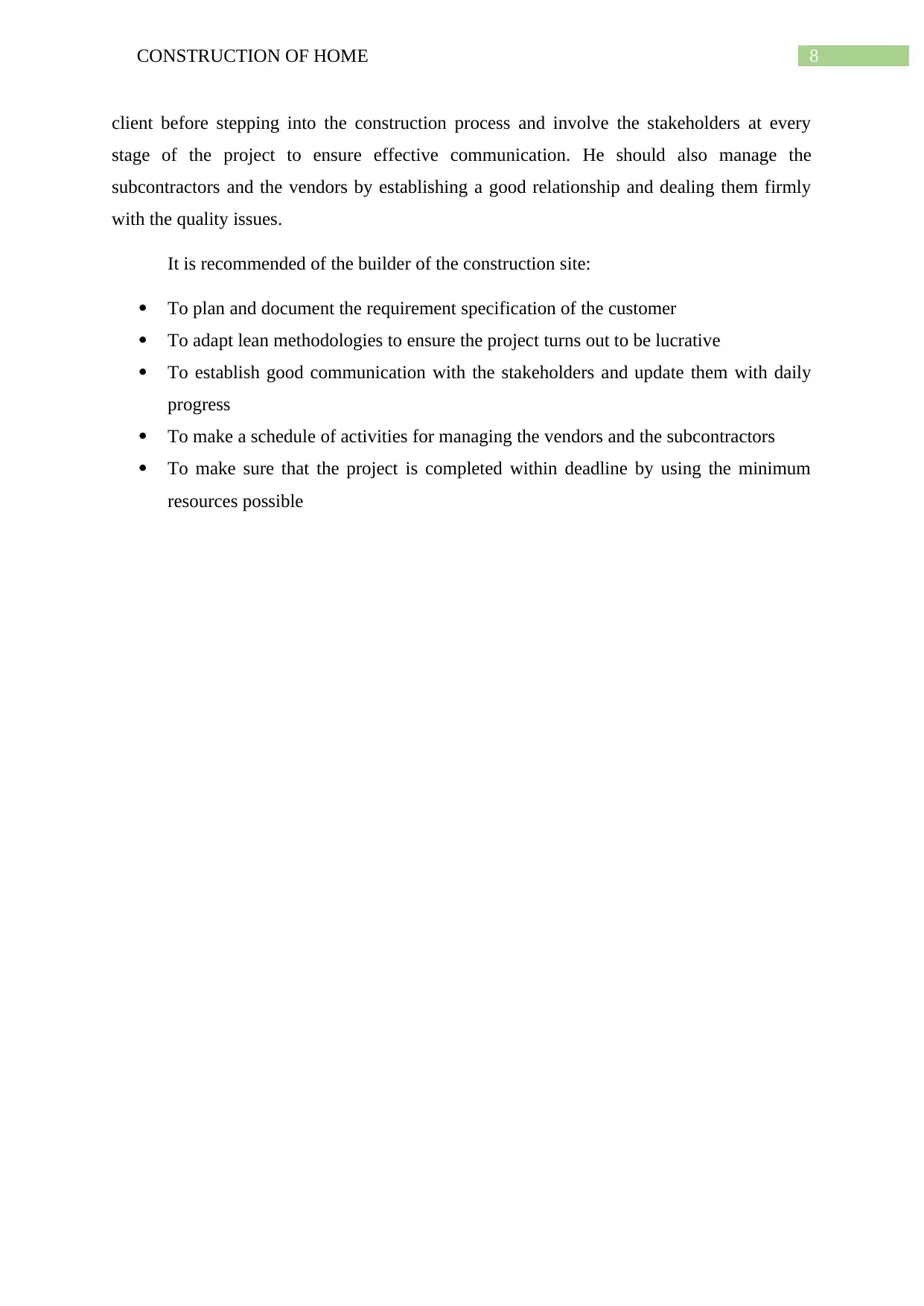
8CONSTRUCTION OF HOME
client before stepping into the construction process and involve the stakeholders at every
stage of the project to ensure effective communication. He should also manage the
subcontractors and the vendors by establishing a good relationship and dealing them firmly
with the quality issues.
It is recommended of the builder of the construction site:
To plan and document the requirement specification of the customer
To adapt lean methodologies to ensure the project turns out to be lucrative
To establish good communication with the stakeholders and update them with daily
progress
To make a schedule of activities for managing the vendors and the subcontractors
To make sure that the project is completed within deadline by using the minimum
resources possible
client before stepping into the construction process and involve the stakeholders at every
stage of the project to ensure effective communication. He should also manage the
subcontractors and the vendors by establishing a good relationship and dealing them firmly
with the quality issues.
It is recommended of the builder of the construction site:
To plan and document the requirement specification of the customer
To adapt lean methodologies to ensure the project turns out to be lucrative
To establish good communication with the stakeholders and update them with daily
progress
To make a schedule of activities for managing the vendors and the subcontractors
To make sure that the project is completed within deadline by using the minimum
resources possible
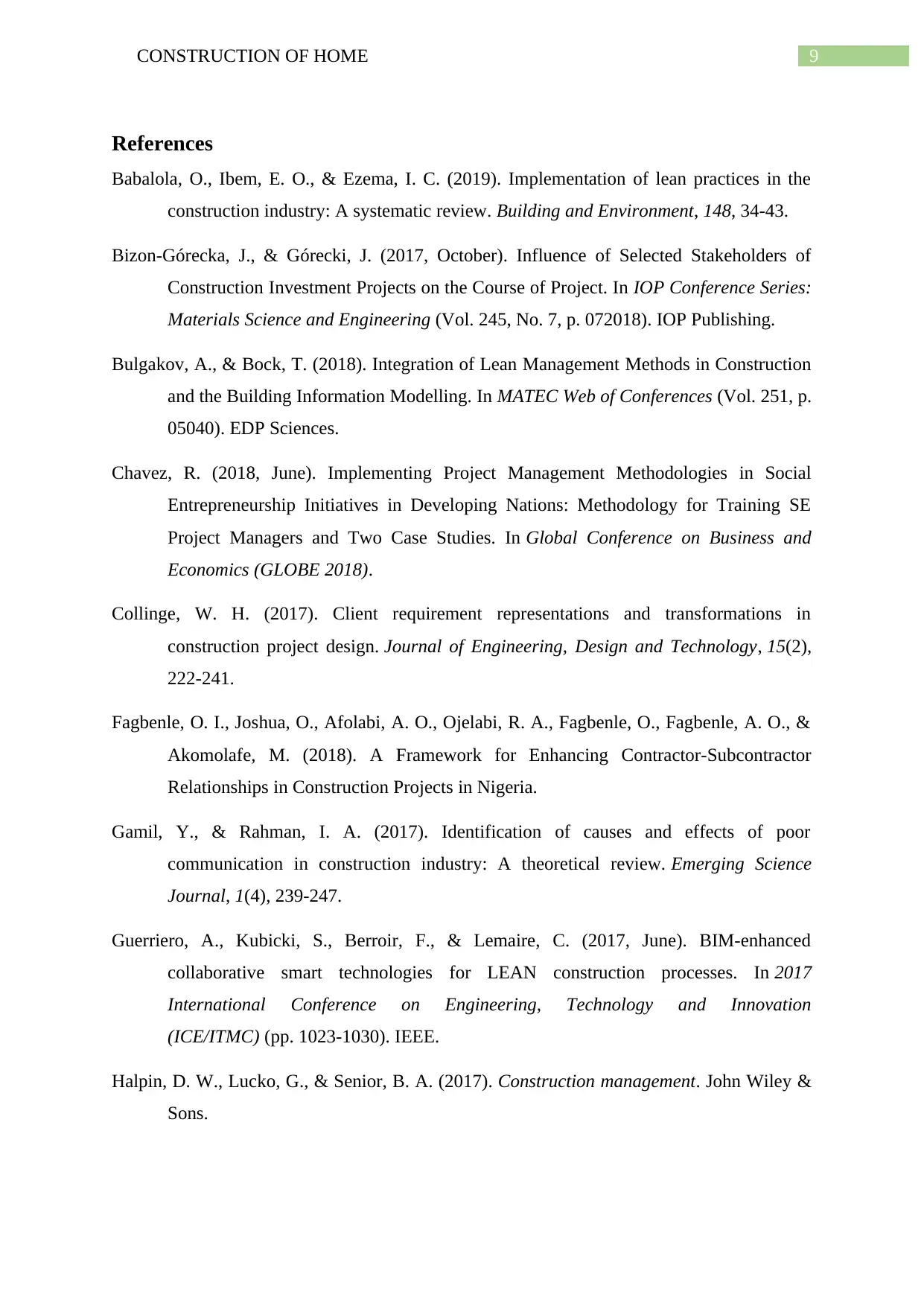
9CONSTRUCTION OF HOME
References
Babalola, O., Ibem, E. O., & Ezema, I. C. (2019). Implementation of lean practices in the
construction industry: A systematic review. Building and Environment, 148, 34-43.
Bizon-Górecka, J., & Górecki, J. (2017, October). Influence of Selected Stakeholders of
Construction Investment Projects on the Course of Project. In IOP Conference Series:
Materials Science and Engineering (Vol. 245, No. 7, p. 072018). IOP Publishing.
Bulgakov, A., & Bock, T. (2018). Integration of Lean Management Methods in Construction
and the Building Information Modelling. In MATEC Web of Conferences (Vol. 251, p.
05040). EDP Sciences.
Chavez, R. (2018, June). Implementing Project Management Methodologies in Social
Entrepreneurship Initiatives in Developing Nations: Methodology for Training SE
Project Managers and Two Case Studies. In Global Conference on Business and
Economics (GLOBE 2018).
Collinge, W. H. (2017). Client requirement representations and transformations in
construction project design. Journal of Engineering, Design and Technology, 15(2),
222-241.
Fagbenle, O. I., Joshua, O., Afolabi, A. O., Ojelabi, R. A., Fagbenle, O., Fagbenle, A. O., &
Akomolafe, M. (2018). A Framework for Enhancing Contractor-Subcontractor
Relationships in Construction Projects in Nigeria.
Gamil, Y., & Rahman, I. A. (2017). Identification of causes and effects of poor
communication in construction industry: A theoretical review. Emerging Science
Journal, 1(4), 239-247.
Guerriero, A., Kubicki, S., Berroir, F., & Lemaire, C. (2017, June). BIM-enhanced
collaborative smart technologies for LEAN construction processes. In 2017
International Conference on Engineering, Technology and Innovation
(ICE/ITMC) (pp. 1023-1030). IEEE.
Halpin, D. W., Lucko, G., & Senior, B. A. (2017). Construction management. John Wiley &
Sons.
References
Babalola, O., Ibem, E. O., & Ezema, I. C. (2019). Implementation of lean practices in the
construction industry: A systematic review. Building and Environment, 148, 34-43.
Bizon-Górecka, J., & Górecki, J. (2017, October). Influence of Selected Stakeholders of
Construction Investment Projects on the Course of Project. In IOP Conference Series:
Materials Science and Engineering (Vol. 245, No. 7, p. 072018). IOP Publishing.
Bulgakov, A., & Bock, T. (2018). Integration of Lean Management Methods in Construction
and the Building Information Modelling. In MATEC Web of Conferences (Vol. 251, p.
05040). EDP Sciences.
Chavez, R. (2018, June). Implementing Project Management Methodologies in Social
Entrepreneurship Initiatives in Developing Nations: Methodology for Training SE
Project Managers and Two Case Studies. In Global Conference on Business and
Economics (GLOBE 2018).
Collinge, W. H. (2017). Client requirement representations and transformations in
construction project design. Journal of Engineering, Design and Technology, 15(2),
222-241.
Fagbenle, O. I., Joshua, O., Afolabi, A. O., Ojelabi, R. A., Fagbenle, O., Fagbenle, A. O., &
Akomolafe, M. (2018). A Framework for Enhancing Contractor-Subcontractor
Relationships in Construction Projects in Nigeria.
Gamil, Y., & Rahman, I. A. (2017). Identification of causes and effects of poor
communication in construction industry: A theoretical review. Emerging Science
Journal, 1(4), 239-247.
Guerriero, A., Kubicki, S., Berroir, F., & Lemaire, C. (2017, June). BIM-enhanced
collaborative smart technologies for LEAN construction processes. In 2017
International Conference on Engineering, Technology and Innovation
(ICE/ITMC) (pp. 1023-1030). IEEE.
Halpin, D. W., Lucko, G., & Senior, B. A. (2017). Construction management. John Wiley &
Sons.
Secure Best Marks with AI Grader
Need help grading? Try our AI Grader for instant feedback on your assignments.
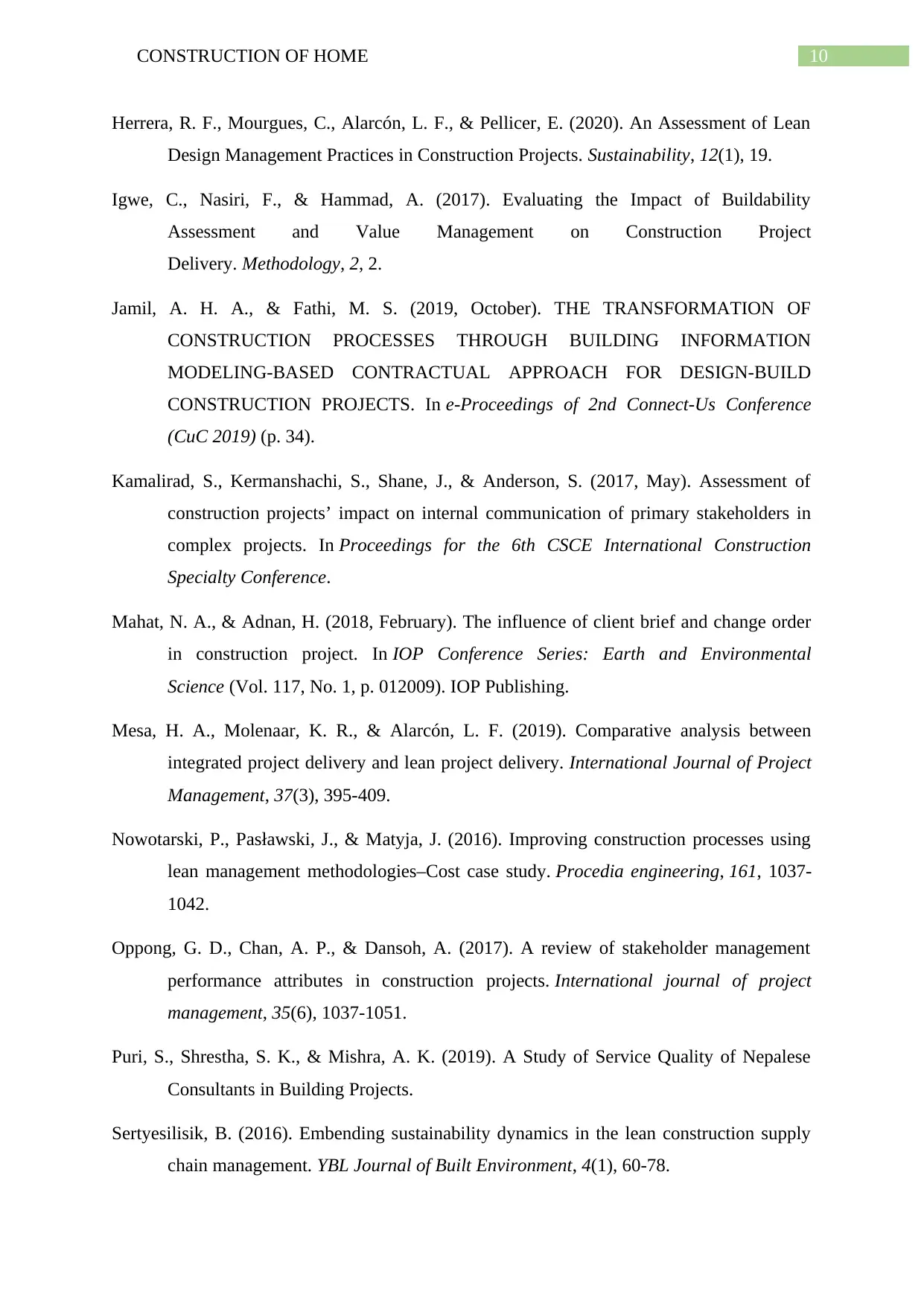
10CONSTRUCTION OF HOME
Herrera, R. F., Mourgues, C., Alarcón, L. F., & Pellicer, E. (2020). An Assessment of Lean
Design Management Practices in Construction Projects. Sustainability, 12(1), 19.
Igwe, C., Nasiri, F., & Hammad, A. (2017). Evaluating the Impact of Buildability
Assessment and Value Management on Construction Project
Delivery. Methodology, 2, 2.
Jamil, A. H. A., & Fathi, M. S. (2019, October). THE TRANSFORMATION OF
CONSTRUCTION PROCESSES THROUGH BUILDING INFORMATION
MODELING-BASED CONTRACTUAL APPROACH FOR DESIGN-BUILD
CONSTRUCTION PROJECTS. In e-Proceedings of 2nd Connect-Us Conference
(CuC 2019) (p. 34).
Kamalirad, S., Kermanshachi, S., Shane, J., & Anderson, S. (2017, May). Assessment of
construction projects’ impact on internal communication of primary stakeholders in
complex projects. In Proceedings for the 6th CSCE International Construction
Specialty Conference.
Mahat, N. A., & Adnan, H. (2018, February). The influence of client brief and change order
in construction project. In IOP Conference Series: Earth and Environmental
Science (Vol. 117, No. 1, p. 012009). IOP Publishing.
Mesa, H. A., Molenaar, K. R., & Alarcón, L. F. (2019). Comparative analysis between
integrated project delivery and lean project delivery. International Journal of Project
Management, 37(3), 395-409.
Nowotarski, P., Pasławski, J., & Matyja, J. (2016). Improving construction processes using
lean management methodologies–Cost case study. Procedia engineering, 161, 1037-
1042.
Oppong, G. D., Chan, A. P., & Dansoh, A. (2017). A review of stakeholder management
performance attributes in construction projects. International journal of project
management, 35(6), 1037-1051.
Puri, S., Shrestha, S. K., & Mishra, A. K. (2019). A Study of Service Quality of Nepalese
Consultants in Building Projects.
Sertyesilisik, B. (2016). Embending sustainability dynamics in the lean construction supply
chain management. YBL Journal of Built Environment, 4(1), 60-78.
Herrera, R. F., Mourgues, C., Alarcón, L. F., & Pellicer, E. (2020). An Assessment of Lean
Design Management Practices in Construction Projects. Sustainability, 12(1), 19.
Igwe, C., Nasiri, F., & Hammad, A. (2017). Evaluating the Impact of Buildability
Assessment and Value Management on Construction Project
Delivery. Methodology, 2, 2.
Jamil, A. H. A., & Fathi, M. S. (2019, October). THE TRANSFORMATION OF
CONSTRUCTION PROCESSES THROUGH BUILDING INFORMATION
MODELING-BASED CONTRACTUAL APPROACH FOR DESIGN-BUILD
CONSTRUCTION PROJECTS. In e-Proceedings of 2nd Connect-Us Conference
(CuC 2019) (p. 34).
Kamalirad, S., Kermanshachi, S., Shane, J., & Anderson, S. (2017, May). Assessment of
construction projects’ impact on internal communication of primary stakeholders in
complex projects. In Proceedings for the 6th CSCE International Construction
Specialty Conference.
Mahat, N. A., & Adnan, H. (2018, February). The influence of client brief and change order
in construction project. In IOP Conference Series: Earth and Environmental
Science (Vol. 117, No. 1, p. 012009). IOP Publishing.
Mesa, H. A., Molenaar, K. R., & Alarcón, L. F. (2019). Comparative analysis between
integrated project delivery and lean project delivery. International Journal of Project
Management, 37(3), 395-409.
Nowotarski, P., Pasławski, J., & Matyja, J. (2016). Improving construction processes using
lean management methodologies–Cost case study. Procedia engineering, 161, 1037-
1042.
Oppong, G. D., Chan, A. P., & Dansoh, A. (2017). A review of stakeholder management
performance attributes in construction projects. International journal of project
management, 35(6), 1037-1051.
Puri, S., Shrestha, S. K., & Mishra, A. K. (2019). A Study of Service Quality of Nepalese
Consultants in Building Projects.
Sertyesilisik, B. (2016). Embending sustainability dynamics in the lean construction supply
chain management. YBL Journal of Built Environment, 4(1), 60-78.
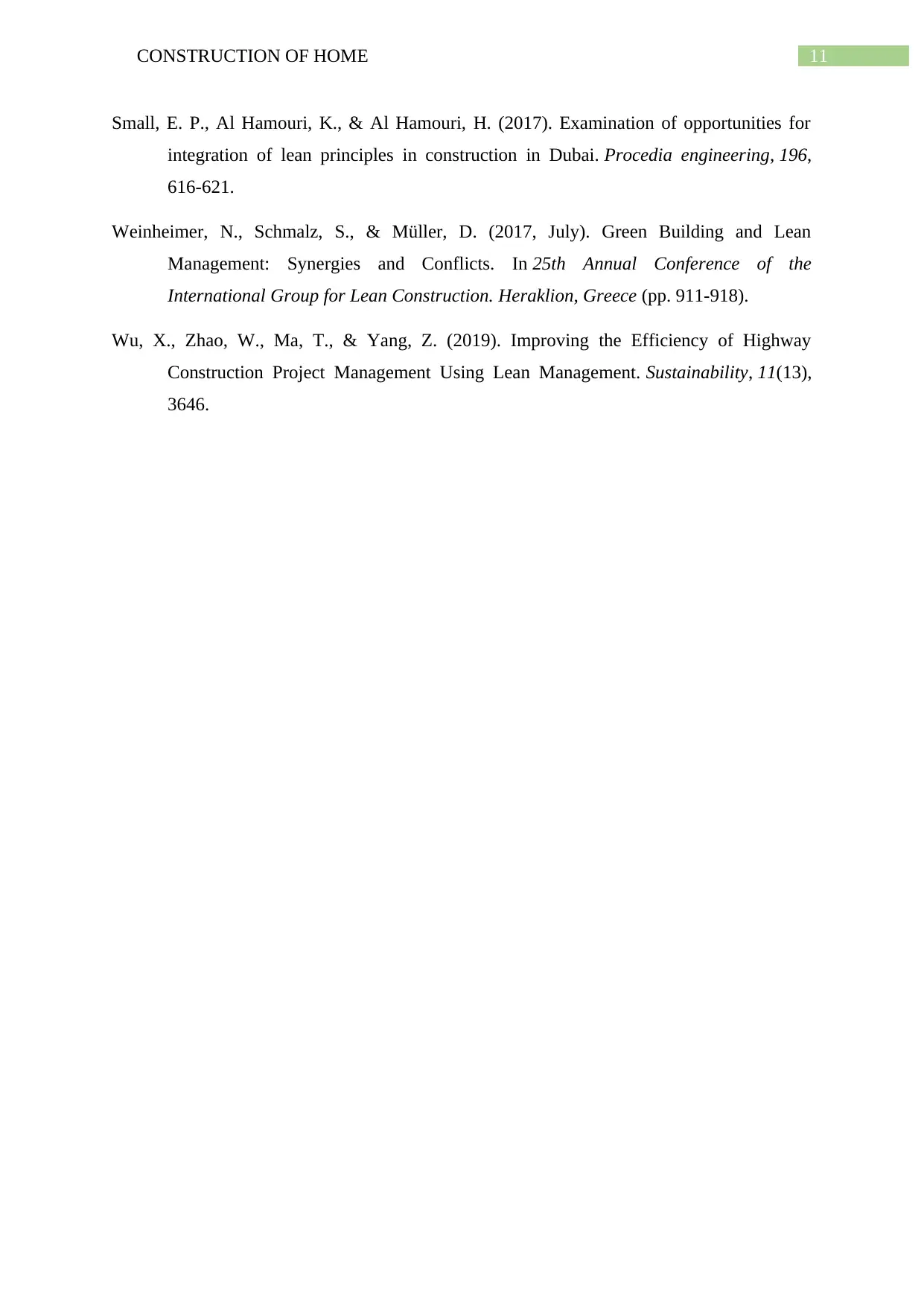
11CONSTRUCTION OF HOME
Small, E. P., Al Hamouri, K., & Al Hamouri, H. (2017). Examination of opportunities for
integration of lean principles in construction in Dubai. Procedia engineering, 196,
616-621.
Weinheimer, N., Schmalz, S., & Müller, D. (2017, July). Green Building and Lean
Management: Synergies and Conflicts. In 25th Annual Conference of the
International Group for Lean Construction. Heraklion, Greece (pp. 911-918).
Wu, X., Zhao, W., Ma, T., & Yang, Z. (2019). Improving the Efficiency of Highway
Construction Project Management Using Lean Management. Sustainability, 11(13),
3646.
Small, E. P., Al Hamouri, K., & Al Hamouri, H. (2017). Examination of opportunities for
integration of lean principles in construction in Dubai. Procedia engineering, 196,
616-621.
Weinheimer, N., Schmalz, S., & Müller, D. (2017, July). Green Building and Lean
Management: Synergies and Conflicts. In 25th Annual Conference of the
International Group for Lean Construction. Heraklion, Greece (pp. 911-918).
Wu, X., Zhao, W., Ma, T., & Yang, Z. (2019). Improving the Efficiency of Highway
Construction Project Management Using Lean Management. Sustainability, 11(13),
3646.
1 out of 12
Related Documents
Your All-in-One AI-Powered Toolkit for Academic Success.
+13062052269
info@desklib.com
Available 24*7 on WhatsApp / Email
![[object Object]](/_next/static/media/star-bottom.7253800d.svg)
Unlock your academic potential
© 2024 | Zucol Services PVT LTD | All rights reserved.





